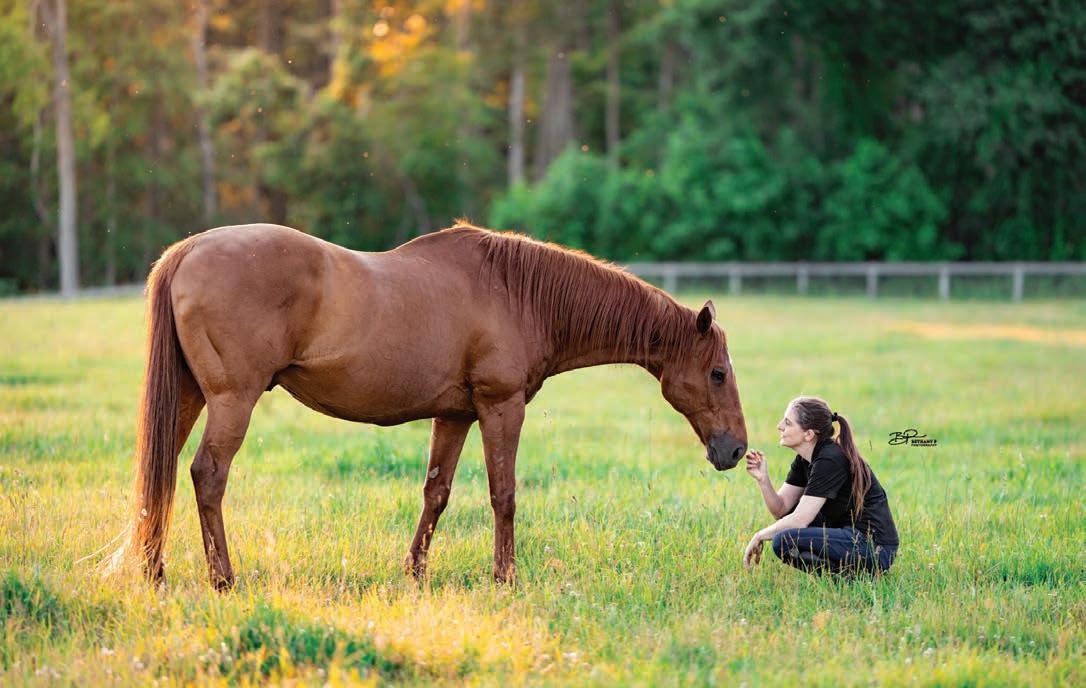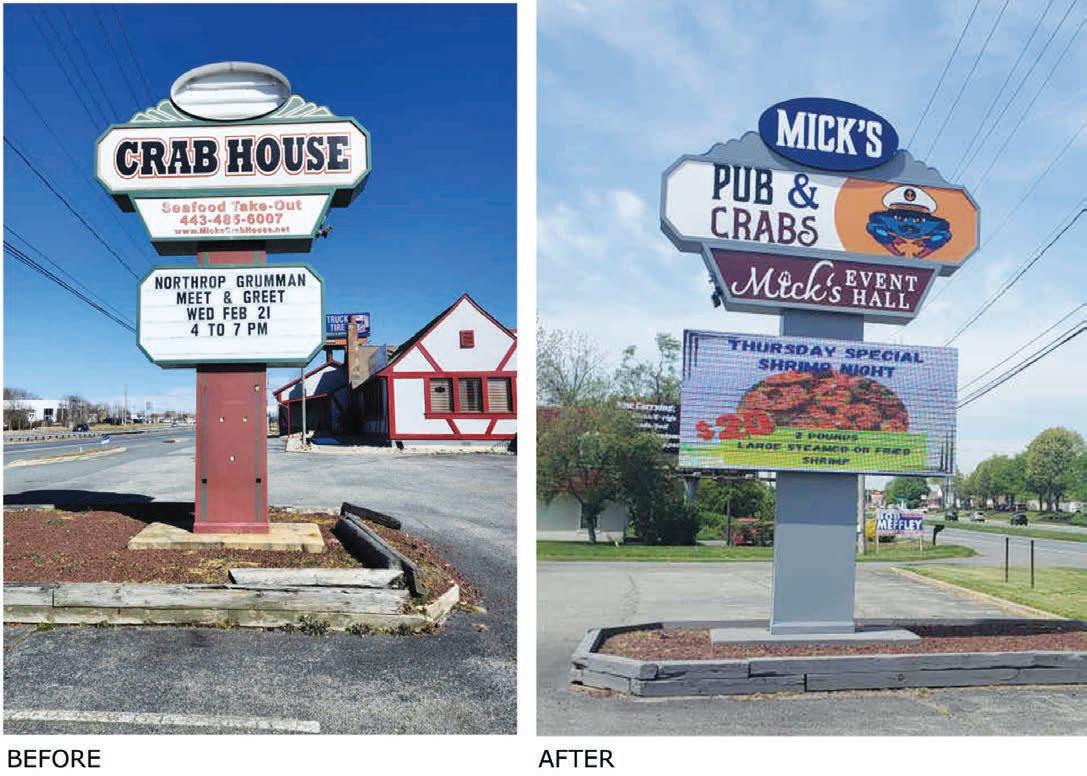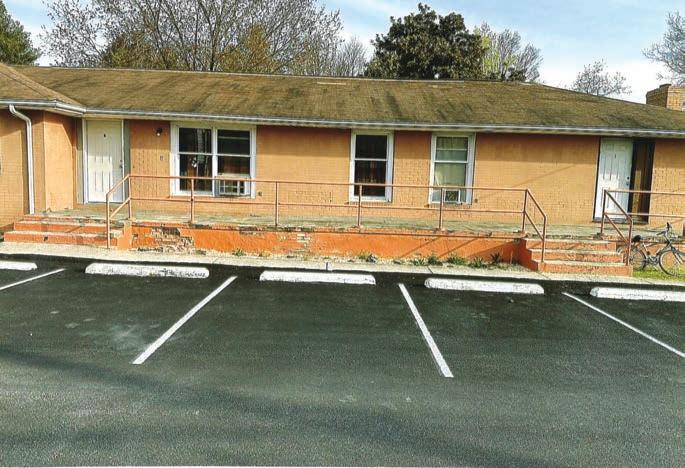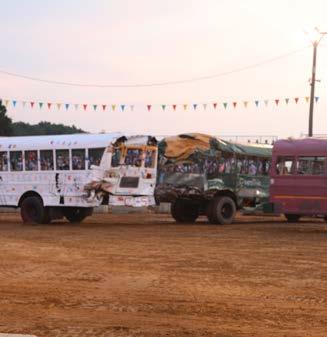


























In this edition of Cecil County Life, we proudly present a photo essay by Jim Coarse that captures the many different facets of life in Cecil County. Through the magic of his lens, Coarse presents a tapestry of beauty and moments that captures the county in photographs.
Another highlight of this edition is a story about After The Races, a wonderful Cecil County organization that works to rehabilitate and re-home retiring Thoroughbred racehorses by finding them suitable, long-term homes while promoting the versatility and usefulness of the breed beyond Thoroughbred racing. After The Races was founded 14 years ago by Bonnie McRae, who had worked in the Thoroughbred racing industry.
For years, the Route 40 Corridor has been the valuable scenic, cultural and economic tributary for Cecil County and beyond. Now, a new grant program is helping to revitalize and upgrade the highway’s aesthetics.
Following the passage of a ballot referendum, marijuana became legal in Maryland in 2023. While the sale of cannabis has become a big business in the state, the industry is still battling stereotypes, and we take a look at the impact that marijuana legalization has had on Cecil County.
For the Cecil County Life Q & A, we talk to April Stern, the director of advising and dual enrollment for Cecil College.
The Cecil College Athletics Hall of Fame celebrated the remarkable achievements of John Rajaski, Joseph McCahon Jr., Mike Wilson, and Alicia Nutter, four icons who have left an indelible mark on the college’s athletic programs. Summer in Cecil County is more than just a season—it’s a feeling. It’s the sound of live music floating through warm air, the scent of lavender fields in bloom, and the taste of fresh seafood by the water. Whether you’re a lifelong resident or planning a weekend escape, there are many ways to soak up the sunshine in this charming corner of Maryland. We present a quick guide to some of the events and activities to enjoy in Cecil County this next season. We hope you enjoy the stories in this issue of Cecil County Life, and we look forward to bringing you the next issue of the magazine in the fall of 2025.
Sincerely,


Cover design: Tricia Hoadley
Cover photo: Jim Coarse

By Marcella Peyre-Ferry Contributing Writer
The Thoroughbred racing industry is big business in the state of Maryland and nationwide. At the center of it all are the horses, but what happens to those equine athletes when they retire?
It might be an injury that takes them out of the running, or perhaps they are not as fast as the others, or maybe age has ended their career. The future is not necessarily a bright one for a retired racehorse unless organizations like After The Races step in to help.
The mission statement for After The Races is to rehabilitate and re-home retiring Thoroughbred racehorses by finding them suitable, long-term homes while promoting the versatility and usefulness of the breed beyond Thoroughbred racing.
The non-profit After The Races goes about this mission in cooperation with race track-based organizations such as Beyond the Wire. These programs connect horses that are about to be retired with off-track resources.
After The Races was founded 14 years ago by Bonnie McRae, who had worked in the Thoroughbred racing industry for ten years, and at one point managed a racing barn.
“I’ve had my feet in the racing industry quite a bit. This sounded like something I could do,” Bonnie said. “The need was so great when I started this. We’ve re-homed 960 horses since 2011. Having started horses for the track and having ridden racehorses, I feel equipped to give
them a safe transition, and being able to restart these guys off the track is something I enjoy.”
Horses typically come directly to After The Races from racetracks in Maryland as well as surrounding states, but racing connections from any state can choose to retire horses through After the Races. Bonnie said that over half of the horses that come to her have been retired due to injuries.
The only requirement for a horse to become a part of the program is that they must have raced or had race training.
“We do always have a wait list,” Bonnie said.
Intake involves a veterinary exam to ensure that horses with injuries will be able to recover and to plan a course of treatment. For the unfortunate few that have catastrophic injuries that are beyond helping, there is a peaceful end to their suffering.
Some horses that come to After The Races with no physical problems are ready to go to new homes in a matter of days. Others may need additional time, care, and training.
“Mostly, I try to keep a balance of rehab horses and sound horses,” Bonnie said. “We will take post-operative horses if they need specialized care after surgery. As long as we believe that a horse can get to a walk trot level of soundness, we will continue with their rehab.”
The average stay for a horse at After The Races is just 58 days. Bonnie makes sure that in that time the horses receive basic training that will help them succeed in whatever field they enter next.
Continued on Page 10
Continued from Page 9
“We try not to put horses in a box. I want every horse to have a safe home,” Bonnie said. “We start every horse with a foundation in basic dressage. They can go in any direction after that.”
One success story is that of South Fleet who came through After The Races in 2012 and found a home working as a police horse in Philadelphia. With his calm temperament and dependable nature, it was a perfect career for the big Thoroughbred. Known on the force as Captain, he and his officers worked in the city for 12 years, including solo details patrolling the Veterans Stadium area during Philadelphia Eagles football games. At 17 years old, Captain retired once again and returned to After The Races, where he was placed with a lucky new owner who sends frequent updates and should be able to enjoy him for many more years.
Anyone interested in adopting a horse begins by submitting an application and providing ref-

erences. Bonnie explained that they ask open-ended questions to help get to know the person better.
Continued on Page 12


Continued from Page 10
Generally, Bonnie does not place horses with first-time horse owners unless they have a well-established background with horses. In those cases, it also helps if the new owner will be working with a trainer who can help build the horse-rider relationship.
The ideal adopter is a horse-person who has had experience with green horses or Thoroughbreds. It is also important that the horse will be going to a safe environment where there are other horses for company.
“We don’t believe in doing pasture pet homes for lame horses,” Bonnie said. “Using terms like ‘pasture sound’ to describe a horse too lame or uncomfortable to be ridden doesn’t make them sound.”
The future career for the horse can be anything from the show ring to trail rides to ranch work. After The Races has placed horses in 48 states, Canada and the Bahamas.
Some of the horses have physical limitations, such as an injury history that dictates that they should not be used for jumping. Rider limitations may also influence matching a horse and rider, with some people in need of a larger or

smaller horse based on their size and fitness.
If a match does not work out for any reason, the horse can be returned to After The Races, and a new partner can be found.
“We like to set the horse up for success,” Bonnie said. “With the effort we spend to make a good match, our retention rate is very high.”
Continued on Page 14


The mission statement for After The Races is to rehabilitate and re-home retiring Thoroughbred racehorses by finding them suitable, long-term homes while promoting the versatility and usefulness of the breed beyond Thoroughbred racing.


Continued from Page 12
Helping with the work at After The Races are 30 to 40 active volunteers. No previous experience with horses is needed, since there are jobs of all kinds that need to be done.
One of those volunteers is Jeff Chapman, who has been giving his time to After The Races for five-anda-half years.
“When I retired, I decided I wanted to volunteer somewhere, preferably with animals,” Jeff said.
Jeff had no previous experience with horses but he now helps with morning feedings and horse care. He also mows, runs the tractor, fixes fences and helps with many of the maintenance jobs that go with every stable.
Continued on Page 16





Continued from Page 14
“I’ve learned a lot about the bond between people and horses. It’s just amazing to me. The horse community is very large and really dedicated to these horses,” Jeff said. “Horses are amazing. I never knew how developed their personalities are.”
Funding to support the work of After The Races comes in part from horse adoption fees, which average about $1,700 per animal. Funding assistance is also provided by racetrack programs like Beyond The Wire, where owners and trainers pay a small fee into a fund every time a horse races. Beyond that, After The Races depends on donations and volunteers.
After The Races has operated from rented farms until March of this year when they moved to their permanent home on Appleton Road in Elkton. The 20-acre site is expected to have capacity for 24 horses. To reach that goal requires the replacement of deteriorating buildings with a new structure. Fundraising for that project is currently underway, with a gala planned
for September at Martins West in the Baltimore area. Sponsorship opportunities are available. Tickets for that event can be purchased on the organization’s website.
After The Races is accredited with the Thoroughbred Aftercare Alliance run by the Jockey Club and is is an official adoption partner with ASPCA Right Horse, the equine arm of The ASPCA.
For more information, to donate, or to volunteer, check out the website at AfterTheRaces.org. You can also check out After The Races on social media where you can watch a horse’s progress beginning with the “unboxing video” of their arrival at the farm.
After The Races was founded 14 years ago by Bonnie McRae, who had worked in the Thoroughbred racing industry for ten years, and at one point managed a racing barn.









By HaLeigh Abbott Contributing Writer
Summer in Cecil County is more than just a season—it’s a feeling. It’s the sound of live music floating through warm air, the scent of lavender fields in bloom, and the taste of fresh seafood by the water. Whether you’re a lifelong resident or planning a weekend escape, there are so many ways to soak up the sunshine in this charming corner of Maryland. Here are a few of our favorite events and experiences to put on your summer bucket list.
Sunfest in Rising Sun – Small-Town Charm at Its Best Saturday, June 7 | 9 a.m. to 3 p.m. Center Square, Rising Sun | Free Admission
There’s nothing like a hometown festival to kick off the season, and Sunfest delivers just that. Held in the heart of Rising Sun, this day-long celebration starts with a parade at 9 a.m. and rolls right into a lively festival full of food, vendors, games, music, and dancing.
It’s a great day to catch up with neighbors, let the kids run around, support local businesses, and just enjoy being outside. If you’ve never been to Rising Sun, Sunfest is the perfect excuse to visit.
peaceful start to summer
Saturday, June 21 | 9 a.m. to 10:30 a.m. Haven Hill Manor | $55 per person
Looking to slow things down a bit? This outdoor yoga session at Haven Hill Manor offers exactly the kind of serene start to summer we all need. You’ll practice yoga in a blooming lavender field, take part in a grounding crystal sound bath, and leave with a bundle of sage and lavender to carry the calm home with you. All the supplies are provided, but feel free to bring your own mat, blanket, or water. This event is taking place rain or shine, so dress accordingly!
Continued on Page 20
Continued from Page 19

Cecil County Fair – A True Summer Tradition Friday, July 18 to Saturday, July 26 | Fair Hill
The Cecil County Fair is the crown jewel of local summer events—and for good reason. What started back in 1954 as a simple one-day gathering has grown into a nine-day celebration of community and agriculture that now draws more than 75,000 visitors each year.
There’s so much to do: carnival rides, tractor pulls, rodeo shows, pieeating contests, and even cow chip tossing if you’re feeling brave. The fair is also packed with 4-H exhibits, farm animals, crafts, and competitions. Whether you’re 5 or 95, the fair has something for everyone—and it’s a must-do every July.
Continued on Page 22




Continued from Page 20

Live Music at Elkton Music Hall –A night out you’ll remember Check website for full schedule | Elkton
For an evening of good vibes and great music, head to Elkton Music Hall. Their summer lineup features everything from tribute acts like Steal Your Peach (Allman Brothers meets Grateful Dead) and Nirvana, to original bands like Hayley Jane, Indigenous, and Montana Wildaxe.
It’s an easy night out—great sound, great space, and always something new to check out. Whether you’re into jam bands, grunge, or acoustic sets, there’s probably a show with your name on it.
If you haven’t been to Plumpton Park Zoo lately, this summer is a great time to go. Kids love the daily feedings of Kazar the giraffe, and adults will appreciate the laidback, scenic vibe. It’s the kind of place where you can slow down, learn something new, and just enjoy being together.
Perfect for family outings, birthday parties, or just a spontaneous Sunday trip, the zoo is both fun and educational—and who doesn’t love feeding a giraffe?
Continued on Page 24


Continued from Page 22

Craft Workshops at Dove Valley Winery
Saturdays and Sundays | Dove Valley Winery
Tickets include a glass of wine
For a creative escape, spend a weekend afternoon at Dove Valley Winery. Their workshops include everything from stained glass and wreath making to Turkish lanterns and sea glass art—and every ticket comes with a glass of their locally made wine. Their summer lineup includes sweet, fun flavors like Peach, Strawberry Shortcake, and Blueberry Cotton Candy. Whether you’re going solo, with a partner, or as part of a girls’ day out, this is a relaxing way to try something new while enjoying the winery’s beautiful countryside views.
Where to Eat in North East –Local favorites with big flavor
After a day exploring Cecil County, head into North East for a delicious dinner.
The Nauti Goose is the perfect spot if you’re craving fresh seafood and a view. Overlooking the water, it’s a go-to for crab cakes, cocktails, and sunset dinners on the deck. It’s casual, lively, and one of those places that just feels like summer.
If you’re more in the mood for steak and wine, check out Steak & Main, just a short walk away. It’s part steakhouse, part sushi bar, and part wine lover’s dream. Made famous by the TV show “Man vs. Food,” this place makes every meal feel like a special occasion.



There’s something special about summertime here. Maybe it’s the people, maybe it’s the traditions—or maybe it’s just the way the fireflies light up the fields after a long day of fun.
Whatever brings you to Cecil County this summer, you’ll find plenty to do, lots to see, and even more to enjoy. So mark your calendars, grab your sunscreen, and make the most of this sunny season—Cecil County style.
For more information, visit www.SeeCecil.org.

The Cecil College Athletics Hall of Fame celebrated the remarkable achievements of John Rajaski, Joseph McCahon, Jr., Mike Wilson, and Alicia Nutter, four icons who have left an indelible mark on the college’s athletic programs, by inducting them into the Hall of Fame as part of the Class of 2025.
This year’s honorees are recognized not only for their athletic excellence but also for their contributions to the creation, development, and growth of the college’s sports teams. The induction ceremony took place in late March in the Technology Center’s conference room on the North East Campus, where the Hall of Fame committee—comprised of alumni, current coaches, and staff—bestowed honors upon four exceptional individuals.
The Cecil College Athletics Hall of Fame aims to recognize those who have made outstanding contributions to the college’s athletic programs, either through direct participation, support, or a passion for athletics that has helped elevate the colleges reputation.
Here’s a look at the Class of 2025:
A native of Pittsburgh, John Rajaski served as the head men’s basketball coach at Cecil College from 1983 to 1995. His leadership on and off the court earned him the Maryland JUCO Conference Coach of the Year award in 1988.
Rajaski’s career in education spanned more than 40 years. He completed his undergraduate studies at Indiana University of Pennsylvania before earning master’s degrees from Western New Mexico University and the University of Illinois. His coaching journey took him from Gettysburg High School, where he coached boys’ basketball, to Springfield College in Illinois, where he also coached basketball, tennis, and baseball.
At Cecil College, Rajaski not only coached men’s bas-
ketball, tennis, and golf but also served as a Health and Physical Education professor until his retirement in 2009.
Coach Rajaski passed away recently, and his legacy was honored at the ceremony by his wife, Sandy Rajaski, who shared heartfelt memories of her husband’s love for coaching.
“It’s my pleasure to be here this evening to honor John,” Sandy said. “He always said, ‘I can’t believe they pay me to do what I love.’ He loved to teach, he loved to coach, and he found joy in the process of basketball, not just the games. He cherished the opportunity to teach life lessons through the sport and help his players grow both as athletes and as individuals.”

Continued from Page 26
Joseph McCahon, Jr. was a key member of Cecil College’s 1988 Maryland JUCO Championship team under Coach Rajaski. Hailing from Pennsylvania, McCahon played basketball at Bishop Shanahan High School before continuing his career with the Seahawks. Over his two seasons at Cecil College, he scored 729 points, ranking him 19th in career points, and added 241 assists (15th all-time) and 350 rebounds (18th all-time).
After his time at Cecil, McCahon transferred to Salisbury University, where he earned team MVP honors for the 1989-1990 season and finished his career ranked fifth in the school’s history for three-point shooting percentage.
“My time at Cecil College was truly life-changing,” said McCahon. “Basketball taught me the importance of hard work, perseverance, and teamwork. The les-
sons I learned on the court have shaped my life, and I hope my journey can inspire the next generation of student-athletes.”
McCahon also shared how the discipline and resilience he developed through basketball helped him overcome a battle with cancer at the age of 25.
Mike Wilson’s impact on Cecil College baseball is legendary. Originally starting his career at the University of Delaware, Wilson transferred to Cecil College for the 2004-2005 season, where he quickly made his mark. As a freshman, he played in 38 of 53 games, posting an impressive .402 batting average with seven home runs and 51 RBIs. His performance earned him All-Region 20 honors and set the stage for an even more remarkable sophomore season.


“The 2006 season was unforgettable,” said Cecil College Athletic Director Ed Durham. “Mike’s performance that year was nothing short of awe-inspiring.”
Wilson nearly claimed the NJCAA baseball triple crown, leading the nation in home runs (22) and RBIs (84), while finishing fifth with a .473 batting average. He was named First Team All-Maryland JUCO Conference, Player of the Year for the conference, and was selected First Team and Player of the Year for NJCAA’s Region 20.
Ultimately, Wilson was named NJCAA Player of the Year, a prestigious honor given to the top player among more than 500 two-year colleges with baseball programs.
Wilson continued his successful career at Wilmington University and completed his undergraduate studies.
“My years at Cecil College were some of the best of my life,” Wilson said. “Academically and athletically, this place truly felt like home. The staff and faculty were incredibly supportive, and I’m grateful for everything they did to help me succeed.”
For over two decades, Alicia Nutter has been the backbone of the Cecil College athletic department. Serving as the Athletic Services Specialist since 2006, Nutter plays a vital role in the day-to-day operations of the department, ensuring smooth team travel schedules, lodging, and financial logistics. According to Durham, Nutter’s contributions have been invaluable to the success of Cecil’s student-athletes.
“She’s been a constant source of support for our coaches and athletes, and her dedication to improving the student-athlete experience is unparalleled,” said Durham.
In addition to her operational expertise, Nutter has raised over $90,000 for student-athletic scholarships by organizing the College’s annual golf outing. She is also committed to streamlining processes within the department to better serve the needs of the student-athletes.
“Over the years, I’ve taken on many responsibilities, and I’ve learned that every job—whether big or small— plays a crucial role in helping our students succeed,” said Nutter. “I’m proud to be part of this amazing team and contribute to the success of our student-athletes.”

High School students throughout Cecil County and beyond are taking advantage of Cecil College’s Early College Academy. April Stern, Cecil College’s director of advising and dual enrollment, recently met with Cecil County Life to talk about the success of the program and how it helps prepare high school students for their collegiate journeys.
Cecil County Life: The Early College Academy at Cecil College began in 2014-15 with a partnership with the Oxford Area School District and has branched out since to include an academy for homeschooled students and a partnership with Elkton and Perryville high schools. In what ways does the academy enrich the educational journey of those who participate in the program?
April Stern: I’m really proud of our program because of all of the benefits that it provides to the students participating in it. Students are surrounded with support from day one until they walk across the stage at graduation. It gives students a head start to the college experience. We start off with courses that may not be as rigorous as those that they will move onto throughout the years. They have the opportunity to explore elective courses to get a feel for what they will want to major in after graduation as well.
Continued on Page 32





Continued from Page 30
An educational curriculum always begins with a vision. Take me back to the seeds that were first planted for the Early College Academy. Clearly, someone at the college saw a gap – or a potential audience - that needed to be addressed.
Dr. Diane Lane, the now since retired VP of Student Services, had a vision of providing an opportunity for high school students to not only take college courses but to complete an entire associates degree while in high school. She took the chance and built the program in partnership with Oxford Area School District and look where we are today! It’s thriving and growing each year.
Part of the curriculum at the Early College Academy focuses on students being guided through seminars and individualized advising to help them build the academic skills needed to succeed in the classroom. What are the advantages of embracing the Academy’s curriculum, rather than pursuing academic counseling and tutoring at a student’s high school?
We work very closely with the guidance counselors at each high school that the Academy is housed. We approach the student’s journey throughout the four years as a cohesive team. We want to ensure that the students are successful on both the high school and college side of the house. I think that makes the program even more successful because of the positive working relationships we have with each school. Be it the principal, guidance counselor, secretary or even those that work at the district offices, we maintain open communication to ensure the students are taken care of.
Very often, it’s not what a student learns in high school that will benefit them in college, but how they have learned to learn. Talk about the intangibles – the learning beyond the curriculum - that a graduate of the Early College Academy will be equipped with when they receive their Associate of Arts degree from Cecil College.
Continued on Page 34


They are essentially two years ahead of their fellow students when transferring to a four-year institution. They’ve learned how to advocate for themselves, how to utilize the services that a college offers, what a course syllabus is, how to read a college level textbook and how to process that information. Our students understand that when a paper/project/homework is due, they get that work turned in on time. Some of these things sound simple, but I know that as a freshman in college straight from high school, I had to learn all of these things and sometimes I learned them the hard way. Our Early College Academy students enter college having already acquired that knowledge, and have been extremely successful because of it.
Efforts count, but results speak larger volumes. How and where have some of your students taken what they have learned at the Academy?
We’ve had students go all over the United States to continue their education - Texas, Kansas, the Carolinas, Florida, Colorado and to schools all over Pennsylvania, Maryland
and Delaware. Last year, a student went to the Naval Academy, as well. Colleges and universities are seeing these students as great candidates for their own programs due to the hard work and dedication it takes to be a high school student while at the same time earning their college degree.
For the thousands of parents of high school-age students who are reading this article and may be curious to know how the Academy may help their child construct their educational path, what would you like to tell them?
I would tell them that this is an opportunity for their student to get ahead, save money and complete high school in a completely different way. It’s an awesome program and I know that it will continue to grow as more and more of the surrounding community learns about it and sees the successes of these amazing students.
What is your favorite spot in Cecil County?
My home with my husband, our two dogs and our cat.


You toss a dinner party and can invite anyone – famous or not, living or not. Who would you want to see around that table?
All of my grandparents, as well as my in-law grandparents. I want to hear their life stories as an adult to really appreciate who they were and what they did for their families.
What item can always be found in your refrigerator? Dill pickles and olives!
To learn more about the Early College Academy at Cecil College, visit www.cecil.edu/eca
~ Richard L. Gaw

Continued from Page 36
In this new role, Todd Anthony Hurt, a military veteran, hopes to ensure that other veterans see Cecil College as a place where they can thrive and find success
Todd Anthony Hurt, a lifelong Cecil County resident, a 2016 graduate of Cecil College and a proud veteran of the U.S. Air Force, has been appointed to the Cecil College Board of Trustees.
He brings with him a deep-rooted commitment to both education and community service. His appointment highlights the importance of veteran representation in leadership roles, particularly in educational institutions that have long served as “gateways to opportunity for military personnel and their families.”
Continued on Page 38


Continued from Page 36
Hurt’s connection to Cecil College runs deep. He is not only an alumnus but also a passionate advocate for the college’s mission and values. He first attended Cecil College as an adult student using the GI Bill, later earning a degree in Business Management before transferring to the University of Maryland, University College (now University of Maryland Global Campus), where he completed a degree in Business Administration in 2018.
Reflecting on his journey, Hurt said, “Cecil College is a wonderful place for veterans like myself. It enabled me to get the college degree I needed to be successful in life and led to me taking that next big step.”
Currently residing in Port Deposit and serving as a Department of the Army civilian at Aberdeen Proving Ground for the Communications Electronics

Command, Hurt brings a wealth of professional experience to the board. His military background, combined with his time as a contractor with the Army Test Center, underscores his disciplined, missiondriven approach, qualities that align closely with the college’s structured support systems for veterans and non-traditional students.
Hurt’s relationship with Cecil College began years ago when Dr. Mary Way Bolt, now President of the College and then one of his first instructors, helped guide his academic path.
“It is an honor to become a member of the Cecil College Board of Trustees,” Hurt said. “There are definitely some big shoes to fill, and I look forward to working with everyone to improve on what great accomplishments the college has already achieved.”
Hurt, a graduate of Perryville High School, is also

a youth football coach and active community leader.He has coached in Perryville Little League, at Perryville High School, where the team reached the state finals, and he continues to support athletics, including his daughter’s travel softball team. His deep community ties and belief in the value of local education underscore his vision for the college’s role.
“Cecil College plays a huge role as a first choice for students out of high school and for non-traditional students looking to improve their lives,” he said. “As a parent and

a coach, I can spread the knowledge of what Cecil College has and how it can benefit others.”
Family, military, and athletics are cornerstones of Hurt’s life, and these values will undoubtedly shape his contributions as a trustee. With his wife, Adrianne, and their children, Ashlynn, Trent, and Hunter, by his side, he is eager to give back to the college that helped launch his journey. Through his new role, he hopes to ensure other veterans see Cecil College as a place where they, too, can thrive and find success.

|Cecil County Life Photo Essay|

Through the magic of his lens, photographer Jim Coarse has captured Cecil County and in the process, illuminated its grandeur and written its story
Continued on Page 42





Continued from Page 41
From the time he first received a Fisher-Price 110 camera for his fifth birthday, photographer Jim Coarse has followed the power of his lens and the energy of his curiosity and in the process, creates a story in every photograph he takes.
Over the past few decades, Coarse has trained his lens on a wide variety of subjects – the blushing bride, the sinewy mus-


cle of a racehorse heading toward the final leg and the beautiful bend of a brook in the middle of a forest. A graduate of the University of the Arts in Philadelphia, Coarse has been known to bring his cameras on his sailing journeys along the Chesapeake Bay, the Green Mountains of Vermont and along the coral sands of the Caribbean.
Continued on Page 45





Recently, on assignment from Cecil County Life, Coarse was given the creative freedom to wander wherever his camera wished to train its lens on throughout Cecil County, and the results of those journeys – some of which are revealed on these pages –form a tapestry of beauty and moments about a place where we live and work and raise our children and fall in love and disappear into the quiet thicket of a landscape. Here, on these pages, is a love letter to a place and a reminder to everyone who lives here that beauty and moments are fleeting and precious to behold, from the North East River to the Conowingo Dam to the Fair Hill Training Center to Port Deposit.
“For me, the camera is a sketch book, an instrument of intuition and spontaneity,” wrote the photographer Henri Cartier-Bresson. Through his own personal sketchbook of Cecil County, Jim Coarse continues to merge beauty and moments together, and for those on the other side of that magic, we are ourselves beholden to that same magic.
To learn more about photographer Jim Coarse and Moonloop Photography, visit www.moonloopphoto.com.

For years, the Route 40 Corridor has been tributary for Cecil County and beyond. Now, a upgrade the highway’s
By Richard L. Gaw Staff Writer
If you are reading this article, there is a surefire chance that you have been a passenger on Route 40 in Cecil County, and therefore you cannot deny that it opens a window onto Maryland’s history, from the Colonial Era to the Industrial Age to the broadening influx of modern technology.
Along this meandering stretch – 220 miles from Cecil County to Garrett County, and Maryland’s longest highway – you have crossed canals and stone bridges and seen rolling countrysides. You have visited several businesses along the highway and seen them become a cornerstone of local economic development.
Known as the “Main Street of America,” Route 40 remains a principal east-west artery in a state highway network that

comprises some 29,579 miles of interstate, primary and secondary roads and over 2,400 bridges. The establishment of Route 40 along the Maryland-Delaware line began when the final segment then known as the “Philadelphia Road” was completed in June 1941. At a ceremony held on June 16, Maryland Gov. Herbert R. O’Conor and Delaware Gov. Walter W. Bacon cut the ribbon signifying that the Maryland portion of Route 40 was formally linked to the Delaware thorofare.
The project, which cost $7.3 million, gave passengers and businesses a modern, 47-mile-long highway between Wilmington and Baltimore.
In May 1944, the Philadelphia Road was rededicated as the Pulaski Highway, named after the Polish patriot and friend of Revolutionary War America.
Continued on Page 48
the valuable scenic, cultural and economic new grant program is helping to revitalize and highway’s aesthetics


Continued from Page 46

Route 40 also put Cecil County on the map during the rising racial tensions of the 1960s in America and served as a primary road that was used by the Congress of Racial Equality (CORE) during their freedom marches to end segregation. In December 1961, more than 700 freedom riders rolled up and down the road in northeastern Maryland, demonstrating at 40 segregated restaurants. Unfortunately, however, you cannot deny that over the past few decades, you have witnessed a snake river of neglect and dust along the highway, reflected in outdated storefronts and signage that is well past its date of expiration.
Continued on Page 50








Continued from Page 48

In an effort to beautify the highway and rejuvenate its appeal in Cecil County and throughout the state, Maryland recently launched the Route 40 Business Revitalization Grant for Fiscal Year 2025. In alignment with the county’s economic development strategic plan, the program was formed by Cecil County Department of Economic Development, the Department of Community Services and the Department of Land Use and Development Services. Funding for the program is being provided by Maryland’s Video Lottery Terminal Fund (VLT), that uses proceeds from video lottery terminals at six casinos in the state to assist small, minority, and women owned businesses located in targeted areas around the state. The grant’s mission will be to assist businesses and organizations striving to improve their exterior image and function, resulting in an enhanced
Continued on Page 52



Continued from Page 50

visual appearance and increased utilization of the business by the community.
The maximum award per grant application is $25,000, and disbursement of grant funding will only be made on a reimbursement basis.
“The original concept that led to the program began as a way to incentivize organizations and businesses along Route 40 in Cecil County to make improvements and upgrades with two main ideas in mind: to stimulate economic and community development and improve the visual aesthetic of the highway, especially for passengers who drive up and down the corridor,” said Earl Grey, the director of the Cecil County Housing Agency. “Outside of Route I-95 and to a lesser degree Route 1, Route 40 is the gateway for people from Pennsylvania, Delaware and New Jersey.
This is an idea to encourage drivers to get off the highway and see Cecil County as something more important, not just as a road.
“We want to create an aesthetic that is brighter and feels better.”
Through the program, business owners will be eligible to receive improvements to their sidewalks, driveways and parking lots, signage, lighting, siding, entrances, porches, decks and fencing, as well as landscaping/hardscaping and demolition and removal of materials. Existing businesses that include residential accommodations will be considered, but the property must be clearly identified predominantly as a business and maintain regular, publicized operating hours.
Whether a business receives a grant will depend on if they


have completed a detailed application; that all documents have been received; proof that the project description will enhance and revitalize the visual appearance from Route 40; and whether the business is stable and provides a positive impact on the local community.
Continued on Page 54


Continued from Page 53

The improvements can be implemented with a completion date of June 30, 2025.
Grey, who commutes 100 miles round-trip from his home to his office in Elkton along Route 40 said that the program’s success will depend upon a business owner’s willingness to “beautify” his or her storefront, one that he sees could develop as part of a “snowball effect.”
“When a business owner drives past a competitor whose storefront looks cleaner than theirs, not only does that make them think to themselves, ‘This looks
really nice, and maybe I should do that,’ there is the realization that this business is competing with theirs, and that it is financially a wise investment to create a more appealing look,” he said. “The long-term hope of the Route 40 Business Revitalization Grant is to achieve a ‘Rising tides raise all ships’ metaphor up and down the corridor. We have to be patient and hopefully we’ll continue to see those positive changes, and those who drive up and down Route 40 will begin to see those changes as well.”
To apply for the Route 40 Business Revitalization Grant for Fiscal year 2025, visit www.ccgov.org/government/economic-development/ route-40-business-revitalization-program



Following the passage of a ballot referendum, marijuana sale of cannabis has become a big business in the
By Gabbie Burton Contributing Writer
Standing in line at Far and Dotter marijuana dispensary in Elkton, Maryland, you see an array of people come through the dispensary line.
A young woman in Lululemon. A young man in camo and cowboy boots. An older gentleman with a cane. A middle-aged woman with a limp. A man in a veterans’ cap. When you stand in line long enough, you’ll notice a trend. None of the customers coming through are fitting the typical stereotype of a “stoner.”
Legalized marijuana use in Maryland went into effect on July 1, 2023, after voters approved a ballot referendum in the 2022 general election to allow use of cannabis by adults 21 and over for “adult use” of cannabis. During the 2023 legislative session, the Maryland General Assembly passed legislation that provided a framework for implementing legal adult-use sales, including a licensing and taxation framework.
Passed on May 3, 2023, the Cannabis Reform Act authorized existing licensed dispensaries to convert their licenses for dual medical and adult-use sales on July 1, 2023, and also authorized the Maryland Cannabis Administration to issue additional grower, processor, and dispensary licenses, and new incubator licenses over two licensing rounds. In the nearly two years since adult use of marijuana became legal in Maryland, the industry has had an undeniable impact on the state and now includes two dispensaries in Cecil County. This new industry has opened doors, not
more than
is more than
only for the state and county but for those who choose to partake.
“If you sit in a dispensary long enough, you’ll see that your median age is probably in the forties, and an overwhelming amount of the people are well above 40,” said Wendy Bronfien, co-founder and chief brand officer for Curio Wellness. “Most people are buying to alleviate something or feel a different way, but they’re not chasing that THC.”
Bronfein started Curio Wellness with her father in 2014 when they learned Maryland would be starting a medical marijuana program. In 2016, Curio earned their license to begin growing and selling medical marijuana with both their growing location and first Far and Dotter dispensary located in Baltimore County. They have since expanded the business into adult use marijuana and opened two more Far and Dotter dispensaries, one in Elkton where Pharmkent was previously located, and another location in Baltimore County.
Bronfien shares that the Elkton location is “always buzzing,” and is seeing more activity than other locations.
“Even the days of the week that tend to be quieter - just holistically from a dispensary standpoint – we are still pretty busy here,” she said. “I think a lot of that has to do with the proximity to other states and the nature of those programs, whether they only have medical or even if they have adult use. If their product mix isn’t as robust as Maryland, or if their prices aren’t as attractive as Maryland’s, it draws people across the line.”
Continued on Page 58
marijuana became legal in Maryland in 2023. While the the state, the industry is still battling stereotypes

by Andrea
Continued from Page 56
Elkton is located near the border of both Delaware and Pennsylvania, but while Delaware allows adult use, Pennsylvania only allows medical marijuana. While dispensaries can sell to anyone over the age of 21, transporting across state lines remains illegal.
No matter where they may be coming from, Bronfien believes the people who are seeking out adult use marijuana are doing so for their well-being rather than for the explicit purpose of getting high.
“A majority of people who are shopping adult use are shopping therapeutically and we’ve done that research to confirm it,” she said. “There may be people who are using it from a social buzz perspective, but the overwhelming reasons for adult use consumers that purchase marijuana from a dispensary are to deal with mood, stress, sleep, pain and general forms of relaxation.”
Although many may be using the products therapeutically, they are still buying the product as adult use, which comes with
limitations. In Maryland, adult use marijuana is capped at one and a half ounces of cannabis flower, 12 grams of concentrated cannabis, or a total amount of cannabis products that does not exceed 750 mg THC. Conversely, medical marijuana purchase limits are higher, have no potency restrictions and they do not pay the nine percent tax that adult use is subjected to.
With limitations in place, some users may see reasons to continue buying illegally from dealers to skirt around legal restrictions and pricing. One anonymous Cecil County smoker shared that in the wake of legalization, she and her partner were concerned about the increase in pricing they would see when purchasing legally. Now, cost concerns pale in comparison to the benefits of purchasing the drug legally.
“I felt like I trusted the dealers themselves, but I didn’t trust where they were getting it from so I didn’t know if it was as potent as they said it was, and I didn’t know if it would be laced – luckily that never happened,” she said. “I definitely prefer the dispensary. It can be a little bit more expensive, but to me it’s worth it.”
Continued on Page 60









While customers can feel the pinch of a nine percent tax on their purchases from a dispensary, it seems to be working for the state. Since launching in 2023, state-licensed marijuana retailers have sold more than $1.1 billion in medical and recreational marijuana. Cannabis sales generated nearly $73 million in sales tax revenue for Maryland in 2024, and the industry generated $94.5 million in total sales for January 2025 alone. Revenue from sales is divided among different funds in the state, with 35 percent of it funneled to the Community Reinvestment and Repair Fund; five percent to Maryland counties;


five percent to the Cannabis Public Health Fund; five percent to the Cannabis Business Assistance Fund and the remaining balance directed to the state general fund.
Adult use cannabis will soon be getting even more expensive however, with an increase in sales tax to 12 percent. While this will further increase funds for the state, it also raises fears that users may return to illegal means of obtaining weed if prices are out of reach. Bronfien advised against this, citing safety concerns and limited access.
“I think it’s quite foolish, because if you’re that passionate about consuming the product, I don’t know why you wouldn’t walk into a store where you would have so much variety and so much choice and know that you’re consuming something that is safe,” she said. “We would love to see more people reinstate their goals for medical use, because there’s plenty of people on the adult use side who are purchasing through that lens. They have more access to products, and they wouldn’t feel the tax increase if they were to make that choice.”
While an anonymous source echoed Bronfein’s statements that many users partake for health reasons and that there is an incentive to switch to medical use, she also provided a cautionary tale.
Continued on Page 62





Continued from Page 60
Before she lived in Cecil County, she began smoking weed in Pennsylvania when she was 16, starting at once a week before increasing to daily use. She shared that while her current usage is primarily to sleep and occasionally for the experience of getting a high, she can see how a “dependency can be formed.”
“I went through a period of time where I was not able to eat if I didn’t smoke, so I had to cut back,” she said. “I think [the cannabis industry] definitely needs to warn people that marijuana can become addictive depending on your personality and what you’re going through at the time. People just think it’s nothing but at the end of the day, it is a drug and it’s natural and it definitely helps, but there does need to be more warnings.”
Continued on Page 64



Continued from Page 62
Ultimately, although she has gone through phases in her near decade of marijuana experience, responsible usage of marijuana - especially from a dispensary - has been the most reliable and positive experience for her in her consumption of the drug. From her earlier days as a self-described stoner, she shared her feelings on the stereotypes facing consumers today.
“I think the stereotype of the marijuana user is that of being lazy, unmotivated and tired, but I don’t think that’s accurate,” she said. “It can have that effect on some people, but it’s just about knowing yourself and self-monitoring the proper dosage.”
Continued on Page 66














‘It’s about living your best self’
On the business side, facing stereotypes is also something Bronfein has experience dealing with. She said that facing stigmas and stereotypes within the medical community is a major hurdle.
“We have to be able to try and find ways to give medical professionals information in the way they know it, because that’s how they’re trained to accept it. The more that it can be normalized, the more adoption we’ll see,” she said. “The University of Maryland pharmacy school created the cannabis master’s program and I think that’s been a huge piece. It draws people internationally and they give such a depth of knowledge on this category. I think it’s really instrumental and having a major institution like that really helps to validate the industry.”
Curio Wellness also has a scientific advisory board that helps guide the company’s research for products and innovations.
While the legal cannabis industry is still in its early days in Maryland and restrictions and stigmas still persist, the potential for the industry to thrive in the state and in Cecil County remains for those who believe in it. For those in Cecil County who still may hold on to those stigmas or conversely, those looking to try something new, Bronfien shared what she wants community members to know.
“It’s about understanding that there are really great products available in the dispensary that truly help people and help them achieve a great quality of life,” Bronfien said. “This really isn’t about getting high. It’s about living your best self.”
To learn more about marijuana use in Maryland, visit www.cannabis.maryland.gov, or www.marylandstatecannabis.org.
To contact Contributing Writer Gabbie Burton, email gburton@chestercounty.com.












